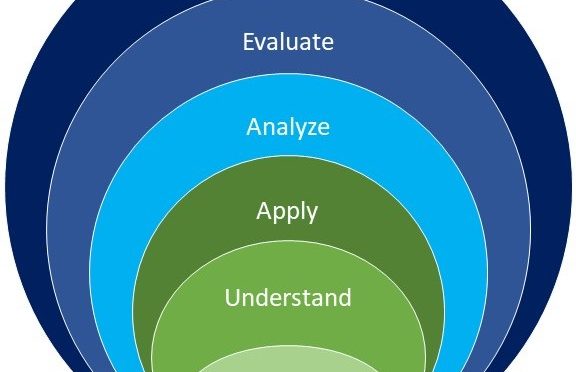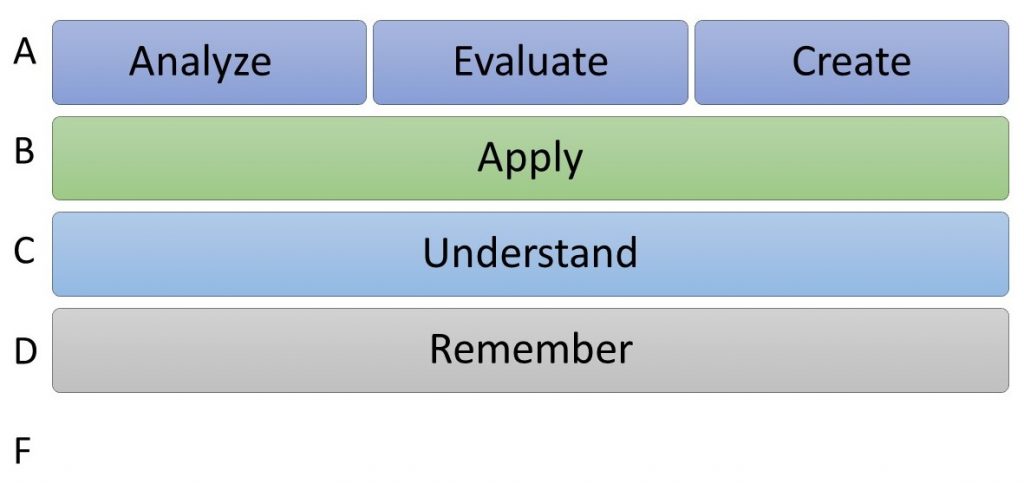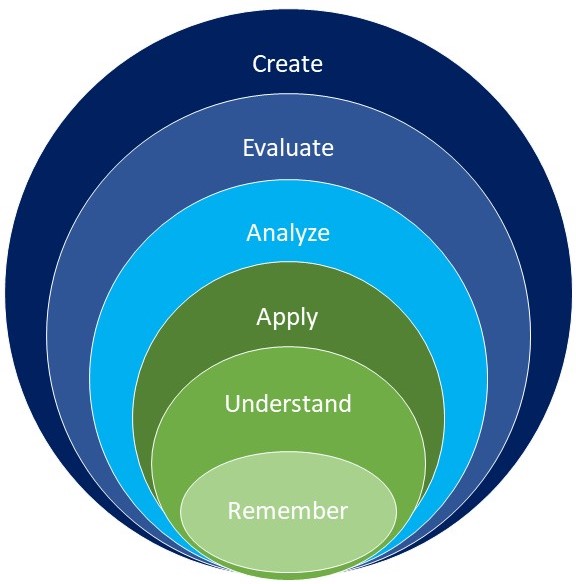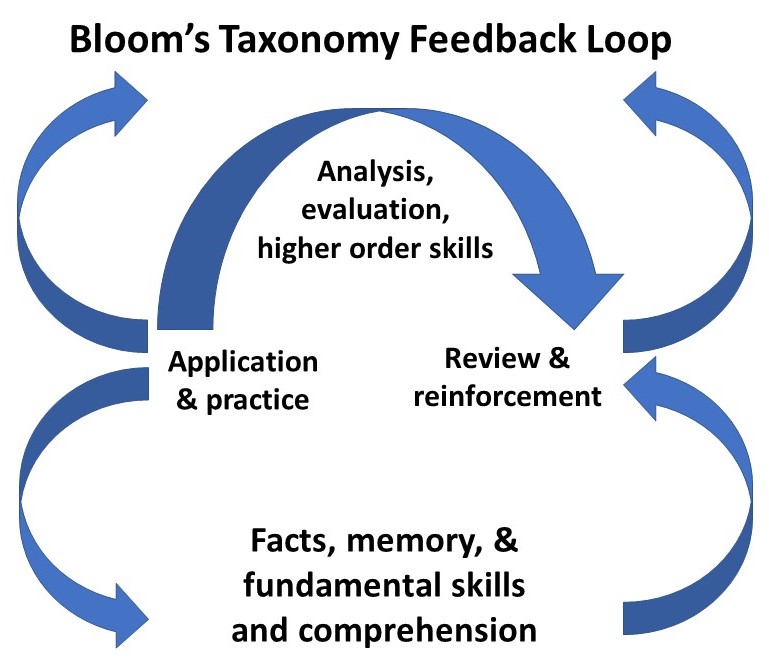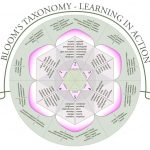 “Bloom’s Taxonomy of the Cognitive Domain,” known more commonly as “Bloom’s Taxonomy,” identifies levels of learning from basic knowledge to higher-order thought that if used correctly can greatly empower student academic performance.
“Bloom’s Taxonomy of the Cognitive Domain,” known more commonly as “Bloom’s Taxonomy,” identifies levels of learning from basic knowledge to higher-order thought that if used correctly can greatly empower student academic performance.
Bloom’s original goal for the taxonomy was to guide curricular and assessment development with specific cognitive goals.
Most teachers are familiar with it, although few use it explicitly in the classroom. Fewer, still, are the students and parents who have heard of Bloom’s Taxonomy.
When engaged explicitly, Bloom’s is a powerful took for scaffolding both lower- and higher-level thought and, most importantly, for empowering student curiosity, academic ownership, and sense of accomplishment.
Using Bloom’s Taxonomy
While reviewing Bloom’s with a student in our A+ Club program, he exclaimed, “That’s on the wall in my English class!” That’s awesome, I replied. But then student said, “But I never had any idea what it was for. She never explained it.”
There you go, I thought to myself, all the education theory in the world lost on a classroom wall!
I do applaud that teacher for displaying Bloom’s, and I’m sure that teacher employs its core ideas, as do most teachers, that knowing information is one thing and using it is another. That’s why teachers always ask students for “analysis,” “evaluation,” “getting beyond the facts” or “taking it to the next level.”
That’s all well and good, but to simply ask students for analysis without teaching the path towards it is destructive of learning.
My strategy as a high school history teacher was to engage Bloom’s taxonomy with my students explicitly, even to the extent of grading students on it’s scale:
In this simple expression of Bloom’s Taxonomy, just “remembering” a fact was worth a D, which is a passing grade. Cool, so you can tell me something about ancient Mesopotamia. When and where is a start, now show me you understand it as something more than just a time and place:
What were its core features and identities? How did it impact other places and times? Why was it important?
From there we can move into the higher-order thinking about ancient Mesopotamia, getting beyond the facts and analyzing and evaluating its conditions, choices, and outcomes and building larger historical understanding.
Core to the process is that basic knowledge is essential for higher-order learning. I can’t teach you to evaluate ancient Mesopotamia if you don’t know anything about it. Here, again, many teachers skip an important step in learning: to build Prior Knowledge in order to apply it to New Knowledge and larger understanding.
How Bloom’s Taxonomy works
The chart above represents is an overly simplistic but necessary first step towards learning how to apply the idea of hierarchies of thought. More complex representations of the Taxonomy express a skill or action that students can identify and act upon for each cognitive level.
Click on this image to review the terms and ideas of the Taxonomy (or right click here to open a hi-res version of the image from Wikipedia in a new tab):
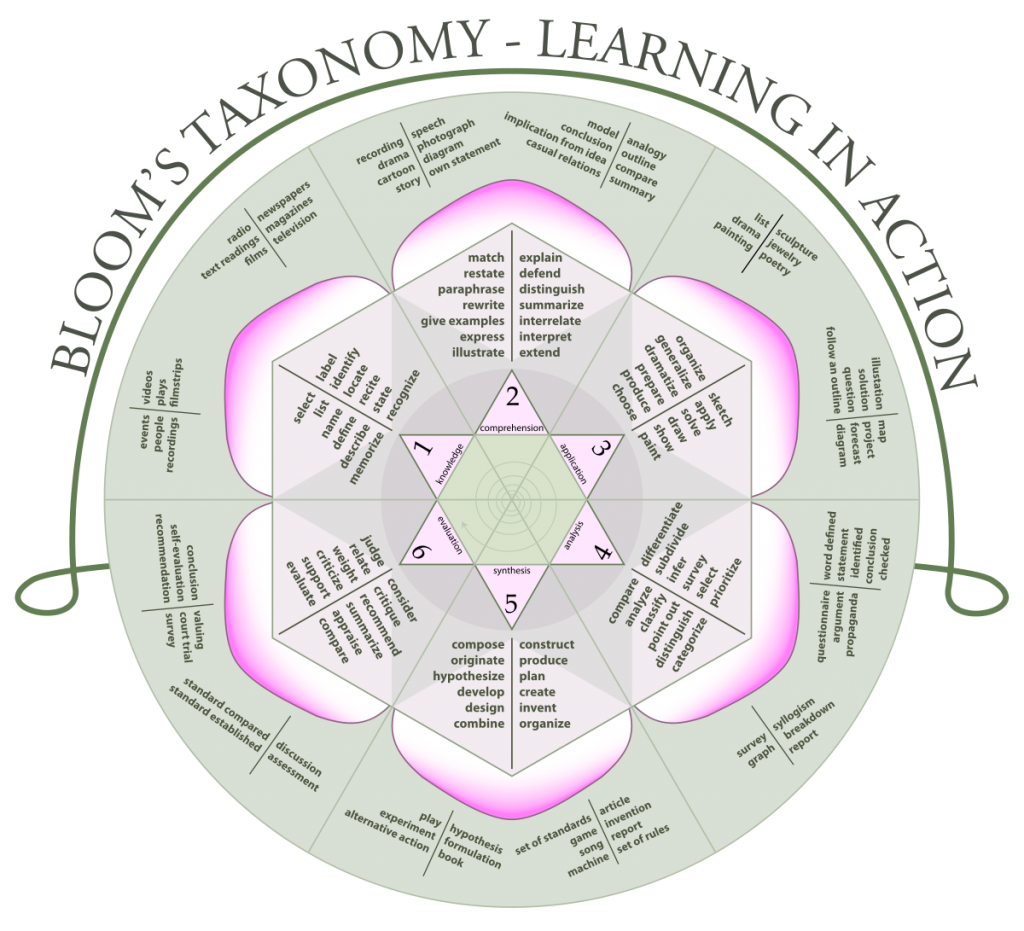
The idea is to attach a verb to each cognitive level, giving students a specific action with which to engage higher-order thought, going from “Understanding,” which employs labeling, memorizing, describing, stating, etc. and onward through the hierarchy to “Evaluation” which entails critiquing, judging, connecting, recommending, etc.
If taught explicitly and with action words attached to each cognitive level, students can embrace and align their lower- and higher-order thought while learning how to explicitly act upon higher-order teacher expectations for analysis and evaluation.
Continuing with Mesopotamia as our example, a simple exercise of aligning information and ideas to the taxonomy shows students how to meaningfully engage Bloom’s:
| Remember | Identify: Mesopotamia was located between two rivers |
| Understand | Explain: The rivers provided water and soil for agriculture and transportation for trade |
| Apply | Draw a map of Mesopotamia and compare it to ancient Egypt |
| Analyze | Classify: The unique characteristics of each river were… |
| Evaluate | Judge: The impact of these characteristics upon the civilization was… |
Note how each step towards higher-order comprehension builds upon the other. Since we cannot analyze what we do not understand, learning about Mesopotamia — or anything — is contingent upon building factual knowledge of it.
This Bloom’s Taxonomy depiction nicely portrays how the hierarchy’s levels are dependent upon one another:
In other words, we can’t learn if we don’t already know something about the topic, building what I call “Prior Knowledge.”
As I discussed in my post, Teach don’t preach, the most common complaint I heard from college-level History department Chairs about incoming freshman students was that they didn’t know basic historical facts. Instead of teaching them higher-order analysis and evaluation, these professors have to teach the historical narrative first, i.e., the lower level learning, per the taxonomy.
Using Bloom’s to Build Student Curiosity
Once empowered by Bloom’s Taxonomy, students necessarily engage in exploration of ideas. That is, when students explicitly build a scaled relationship between lower- and higher-order learning, they intrinsically apply that magical and elusive higher-order characteristic, curiosity.
A quick test of the cognitive level of student engagement is to ask the student to ask a question. Gaps in lower-order thought will show immediately in the “what” and “where” questions, while higher-order thought shows up through devlopment of “how”, “why” and “what about” type questions. These questions clarify student standing on the material and can guide parent or teacher instruction.
For example, I was working with a high-level thinker, a college student and a math/ science whiz, who just couldn’t get out an essay on a literary topic. He was having trouble developing and supporting his thesis because he just didn’t know enough about the literary material itself. We had to back away from the thesis (analysis and evaluation) and work solely on the narratives (remembering, telling) before he could possibly attach larger meaning to them. By questioning him about the literary characters and events, he began to clarify the base-knowledge that was lacking, and then felt empowered to address the larger, higher-order discussion of meaning, value, and interpretation that his thesis required. He went from not engaged with the topic to creating a deeply personal evaluation of it.
Similarly, a high school student told me that she just couldn’t stand her Literature class reading, Albert Camus’ The Stranger. Her teacher quizzed the students on facts about Camus’ life and then threw them into The Stranger without direction. For her, whatever she had learned about Camus had no relationship to the book itself. So, of course it was boring and, frankly, ridiculous, to her, as she had no lower-order, factual context from which to connect and find meaning in the text.
So we stepped back and looked at the larger world around Camus’ life experiences, from his 1930s communism, the French Resistance, and trying to find meaning in the radically different post-War days that followed. As she began to connect her factual knowledge of Camus’ life with its larger context, the reading itself became more interesting to her. Suddenly her innate curiosity allowed her back in to a topic she had shut off.
Using Bloom’s for Math, Science and Language classes
Okay, great, you say, getting kids past the factual barriers in humanities classes is easy, but what about math, science and Spanish or French classes? Don’t they just have to know things and practice it regularly to get there? What’s that got to do with “higher order thought”?
Great questions! — and aligned perfectly with Bloom’s taxonomy. Just in asking these simple questions we can see how creating questions helps extend learning up the hierarchy:
- Learning Math requires strong factual knowledge, i.e. “remembering” and “knowing” with the lowest factual and skill levels essential for learning high level math.
- Math is frustrating and boring to students when the equations or skill sets are beyond student comprehension, thus,
- By using Bloom’s teachers and parents can help students identify what they know from what they don’t know and then scaffold up from there.
- Once empowered by the lower-order knowledge, students will gain confidence and a sense of accomplishment which leads directly to higher-order engagement and overall enjoyment of the task.
Same goes for Science or Spanish.
Too often teachers assume children know the lower-order material and assign higher-order, more complex tasks which students cannot grasp because they lack the fundamental skills and knowledge required of it. Or, teachers may focus so much on the lower-order information that students are left with factual, process-only tasks from which they never learn how to develop higher-order applications.
The Bloom’s Taxonomy Feedback Loop
Bloom’s Taxonomy works best not as a strict hierarchy or scale but as a relationship between those hierarchies, or, as I like to see it, a feedback loop between building up, upon and with knowledge and student expression of it:
Effective learning isn’t walking up Bloom’s like a ladder. Instead it’s a loop of information and processing, all of which leads to relevancy, empowerment, and effective expression of learning and ideas.
Parents and teachers will find students more eager to learn and more able to engage those higher-order skills we want from them once they see a clear path towards it, which Bloom’s Taxonomy and its action words readily provide.
Best of all, when we enter the realm of Bloom’s Taxonomy, it is our own investigations and imaginations at work.
Good luck helping your students find meaning in both the lowest and highest orders of thought and in developing the power of CURIOSITY that can be applied to any topic.
– Michael
